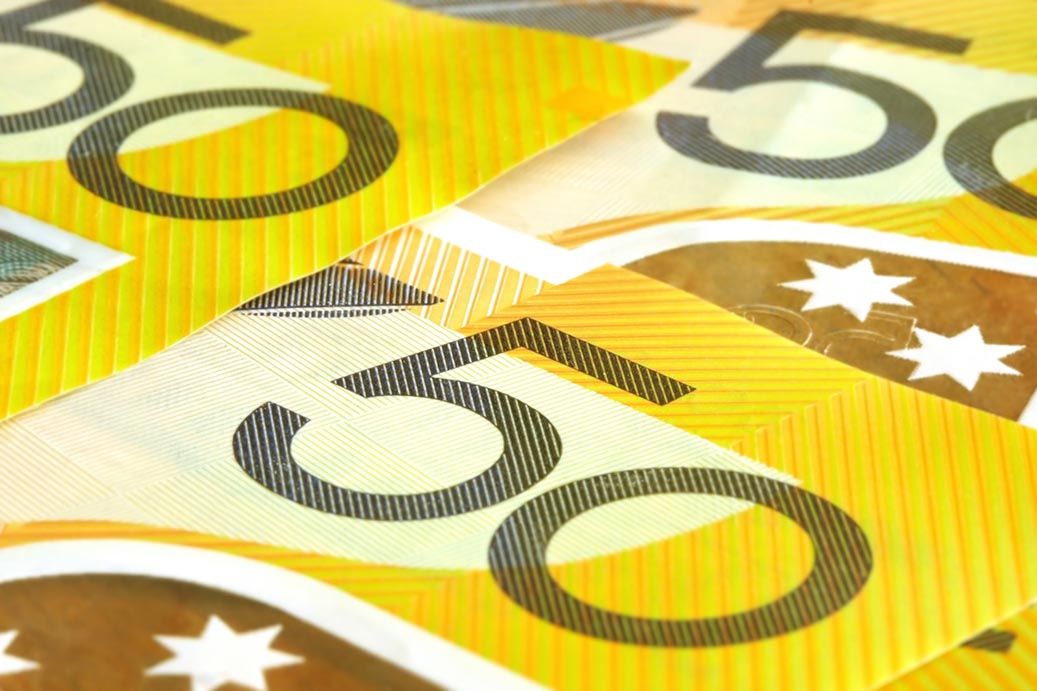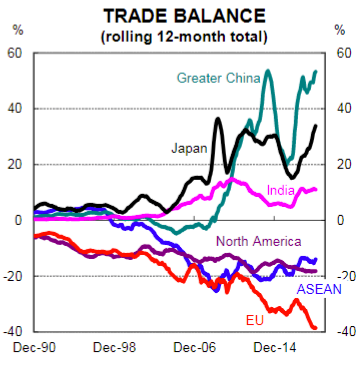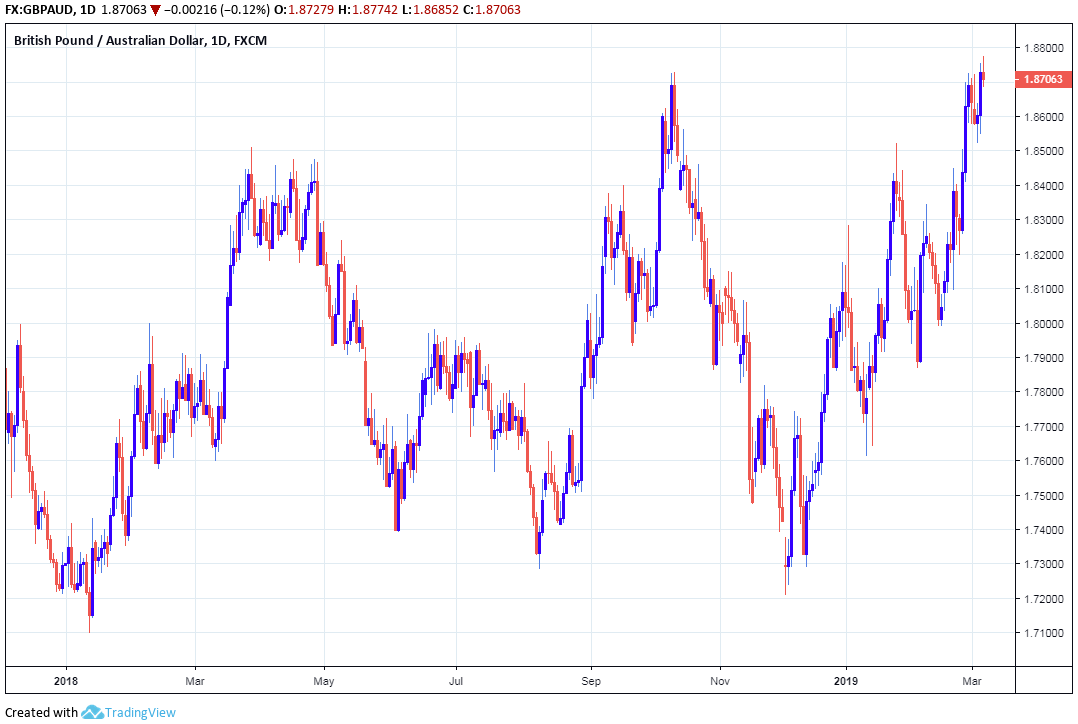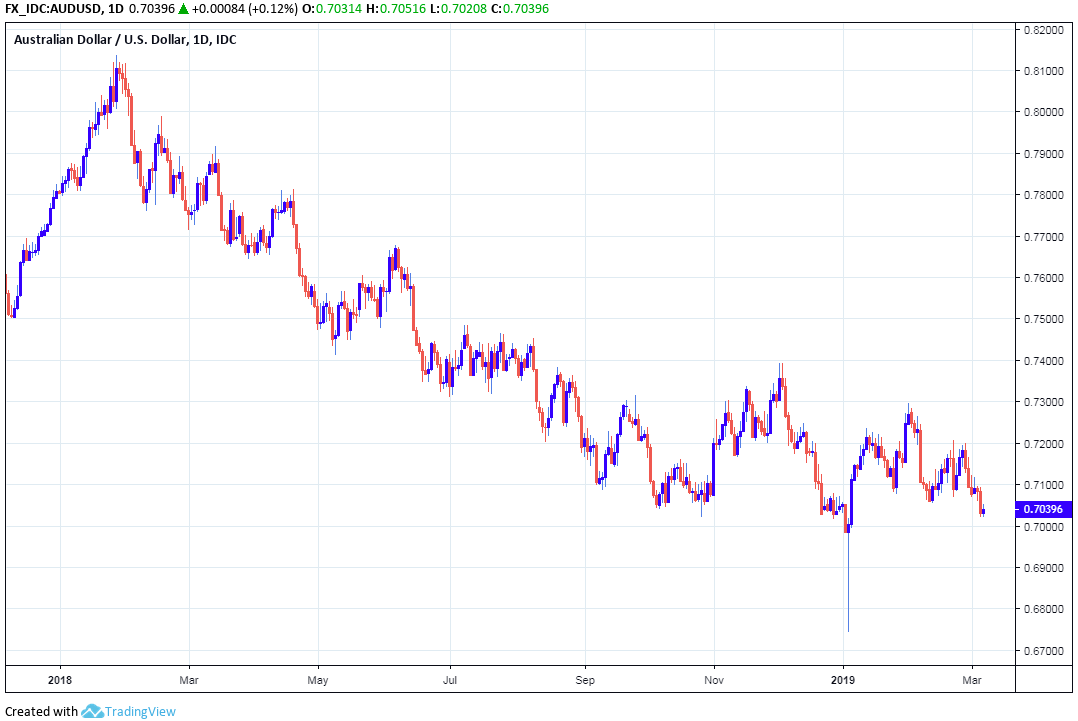The Australian Dollar Recovers Off Wednesday's Lows after January Trade Surplus Surges
- Written by: James Skinner

Image © Robyn Mac, Adobe Stock
- AUD recovers off Wednesday's lows after trade surplus surges.
- Trade data offsets poor retail sales figures for Jan says CBA.
- But the market now sees 100% chance of RBA rate cut in 2019.
The Australian Dollar recovered off earlier lows Thursday after official data revealed a sharp increase in the January trade surplus, which offered support to the Aussie even after other figures showed household spending growth was underwhelming early in the New Year.
Strong trade data was enough to lift the AUD/USD rate off of Wednesday's lows and also encouraged the Pound-to-Australian-Dollar rate to retreat from what was a fresh six-month high scored in the previous session, but some local analysts say it won't be long before the Aussie suffers fresh losses.
Australia's trade surplus rose to $4.55 bn during January, from $3.77 bn previously, when markets had looked for a decline to $2.85 bn. This was the second largest surplus on record, which came after exports grew faster than imports in the New Year.
Imports of goods and services rose by 3% to $35.38 bn in January while exports rose 5% to $39.93 bn although much of the latter increase was due to improved international demand for gold.
"AUD/USD lifted back towards 0.75 in the Asian trading session because the Australian January trade surplus rose to its second highest level on record," says Richard Grace, head of currency strategy at Commonwealth Bank of Australia. "Strong trade data more than offset the impact of lower than expected January retail sales."
Trade balance data measures the difference in value between a nation's imports and its exports. Currency markets care about it because the data provides insight into supply and demand of a currency in the "real economy", while also giving a steer on the likely pace of GDP growth in a given period.
A narrowing deficit suggests either that exports and their associated demand for a currency are rising, or that imports and their associated supply of a currency are falling. Both are typically good for a currency while a steadily narrowing trade surplus, or a widening deficit, is a negative influence.
The size and trajectory of a trade surplus or deficit is important for economic growth because imports are a subtraction in the calculation of GDP, while exports represent a credit to the value of economic output. As a result, rising exports and, or, falling imports can help boost the economy.

Above: Australian trade balances with key partners. Source: Commonwealth Bank of Australia.
"The slight gain in January retail sales indicates that the soft spending conditions over the second half of 2018 have extended into 2019. While sales may not be contracting in nominal terms they are likely to be down in volume terms," says Matthew Hassan, an economist at Westpac.
Australian retail sales rose by just 0.1% in January when markets had been looking for a 0.3% increase to partially reverse the -0.4% contraction seen back in December. Sales at food stores and cafes were up that month but not by enough to offset falling sales at furniture and clothing stores and flat sales at household goods stores.
Currency markets care about the retail data because of the impact rising and falling demand has on inflation. It's changes in consumer price pressures that central banks are attempting to manipulate when they tinker with interest rates, which are themselves the raison d'être for most swings in exchange rates.
Changes in interest rates, or hints of them being in the cards, are only normally made in response to movements in inflation but impact currencies because of the push and pull influence they have on international capital flows and their allure for short-term speculators.
"A weaker-than-expected result for retail sales in January, with only a small rebound after the weak December result. This starts consumer spending for the first quarter of 2019 on a weak note, most likely adding to the downward pressure on the RBA’s outlook for household spending," says Felicity Emmett, an economist at Australia & New Zealand Banking Group.

Above: Pound-to-Australian-Dollar rate shown at daily intervals.
The Pound-to-Australian-Dollar rate was down -0.18% lower at 1.8711 Wednesday and has risen 3.2% this year, while the AUD/USD rate was 0.10% higher at 0.7038 but has fallen -0.19% in 2019. The Aussie was higher against most G10 currencies Thursday.
"Despite the positive trade data, AUD remains below the 12 February low of 0.7050, technically opening up the door to further declines in the coming days. It is possible a bearish ECB at today's policy meeting generates enough of a USD bid to drive AUD below 0.70 given the proximity of AUD to the pyschological level," says CBA's Grace.

Above: AUD/USD rate shown at daily intervals.
"The latest GDP data for Australia reinforce our view that the RBA will be forced to cut rates before long. With this in mind – and given our expectations that the housing downturn will deepen; commodity prices will fall; China’s economy will slow; and appetite for risk will wane – we think that the Australian dollar and the ASX 200 will slump this year," says Simona Gambarini of Capital Economics.
Markets are now increasingly speculating that the Reserve Bank of Australia (RBA) will cut its interest rate before the year is out, potentially on more than one occassion, given the economy is deteriorating at a time when inflation has already been running beneath its target for years now.
Australia's economy expanded by 2.3% for 2018 as a whole. That's down from the 2.8% annual pace of growth seen at the end of the third quarter and beneath the RBA's February 2019 forecast for a steady 2.8%, with much of the deceleration having its roots in the household sector.
Analysts and economists are connecting Australia's slowing economy with an ongoing downturn in house prices, which now appears to be having an impact on household confidence and consumers' willingness to spend.
"We think that this is a sign of things to come. Indeed, we expect the ongoing housing downturn to deepen in the coming months, causing GDP growth to fall to 2.0% in 2019 as a whole and prompting the RBA to cut rates twice in the next year or so," says Gambarini.
Policymakers and markets have long been concerned about the impact that house price falls could have on consumer spending and economic growth, with RBA Governor Philip Lowe the latest to opine on the topic.
The RBA's Lowe said in a speech on Tuesday that household spending has risen faster than income during the last five years, in part because of a huge 50% increase in the price of the average home during the same time period.
He warned that with home prices down 9% in the last year, they could still have further to fall and that this could see household spending decline and savings begin to rise. But he also said the impact should be felt mainly by car dealers and furniture sellers.
"The key issue for the RBA is the labour market and Lowe noted that the data on this front have been encouraging," says Elias Haddad, one of Grace's CBA colleagues, on Wednesday. "We don't expect the RBA to be too concerned about the soft Q4 GDP outturn as long as slower growth doesn't translate into slower employment growth."
Time to move your money? Get 3-5% more currency than your bank would offer by using the services of foreign exchange specialists at RationalFX. A specialist broker can deliver you an exchange rate closer to the real market rate, thereby saving you substantial quantities of currency. Find out more here.
* Advertisement




